Recently, I have been more concerned than ever with questions of our (humans’) rights to engage with our wild city spaces. As an artist who creates textile maps of my walks in urban woods and green areas, I love our wildish spaces – the nearby forests, our cities’ underused riverbanks and ravines, the terrains vagues and vacant lots.
I walk these as regularly and as often as I can, and have had a special longing for their relatively benign otherness since I was a child. What a pleasure and relief to find space that isn’t all done up. Isn’t meticulously tended. Doesn’t show the imprimatur of the human hand.
But of course it does.
As a species, we have had an impact on all parts of this globe. Within the cities that I know best, Montreal and Toronto, the woods and green spaces can be either tended and protected, abandoned and ignored, or under threat from development, but still, the growth there represents human histories. My series of textile maps, Nel mezzo del cammin, tells some of these stories using textile piecing and digital and hand embroidery. Generally, I see my work as aesthetic advocacy, arguing for the preservation of urban green spaces and inviting others to enjoy them. Adapting the motto of the late urban adventurer Ninjalicious, my attitude to the urban wild has been “access all areas.”
From this perspective of human entitlement and desire, I was particularly concerned to discover in November 2014 that one of my favourite Toronto woods, the Glendon Forest, had been closed to foot traffic to allow for re-naturalization.
But of course it does.
As a species, we have had an impact on all parts of this globe. Within the cities that I know best, Montreal and Toronto, the woods and green spaces can be either tended and protected, abandoned and ignored, or under threat from development, but still, the growth there represents human histories. My series of textile maps, Nel mezzo del cammin, tells some of these stories using textile piecing and digital and hand embroidery. Generally, I see my work as aesthetic advocacy, arguing for the preservation of urban green spaces and inviting others to enjoy them. Adapting the motto of the late urban adventurer Ninjalicious, my attitude to the urban wild has been “access all areas.”
From this perspective of human entitlement and desire, I was particularly concerned to discover in November 2014 that one of my favourite Toronto woods, the Glendon Forest, had been closed to foot traffic to allow for re-naturalization.
I’d walked the Glendon Forest regularly with my dog, Auggie (1998-2009), when we’d lived in Toronto. Part of the Glendon Campus of York University, this was the first large wooded terrain that I came to know intimately and well, exploring all its back trails on both sides of the Upper Don River. Over countless hours, I encountered the occasional person and dog, but more often was gifted with sightings of beaver, deer, ducks, geese and of course the small mammals that populate city parks. I was surprised by plants, too: bright red trilliums or ‘wake robin’ blooming in the spring, and in the fall, a beautiful silvery vine growing over a stand of sumacs. With research I learned that this was the invasive pest, Dog Strangling Vine or vincetoxicum rossicum, poisonous to the monarch butterflies who mistake it for nourishing milkweed and a colonizing threat to our green spaces and the plants it enmeshes in its fibres. I was both horrified and appreciative of my new learning.
Last fall, six years after my move to Montreal and the end of my regular walks in the Glendon Forest, I returned to find the dog strangling vine even more pervasive than when I left. Yes, I used my knowledge of the back trails to gain access to the closed-off portion of the woods and disobeyed the prohibition to entry. I had been longing for these woods for years, wanting to reconnect with the trails I’d known and loved in an earlier version of life. This time, the dog I took with me was Baloo, Auggie’s worthy successor. Of course, walking with an off-leash dog is even more ethically complex, since their energetic runs can damage undergrowth and disrupt wild creatures. But aren’t they, too, entitled to space to run?
Once inside the fencing, I found that indeed the Glendon Forest was re-naturalizing, as intended. Some footpaths had become overgrown. An old quarry road that once provided a broad walkway down the escarpment had fallen to pieces and was no longer passable. Unchecked erosion along a steep riverbank abruptly ended one small trail. As I attempted to follow my favourite route, I was blocked again and again by the re-surging forest. I drew on my knowledge of alternative walkways until finally there were no more alternatives. I had to retrace my steps.
I’m conflicted about all of it – the idealization of a ‘re-naturalized’ state, the efficacy of closing off the Forest, the possibility that neglecting it actually promotes dereliction and invasion by noxious species, the determination that some species are noxious, and my and others’ use of the space, regardless of the ‘rules’. What is right in this complex, entwined posthuman reality?
I’m conflicted about all of it – the idealization of a ‘re-naturalized’ state, the efficacy of closing off the Forest, the possibility that neglecting it actually promotes dereliction and invasion by noxious species, the determination that some species are noxious, and my and others’ use of the space, regardless of the ‘rules’. What is right in this complex, entwined posthuman reality?
These questions went into creating my Glendon Forest textile map, essentially a story of love and loss, prohibition and transgression, in this particular urban wild. Into the larger pieced fabric that represents the Glendon Forest and surrounding city, among the machine stitching that duplicates prohibiting and explanatory signage, I hand embroidered two trails: in yellow, the lost idealized favourite of the past; and in deep rose, the circuitous ramble and about faces of last November. I hope this artwork conveys some of the complexities of wildness in the city, as I continue to struggle to find answers to the ethical questions it raises for me.
The Glendon Forest and three other of my textile maps of walks in urban woods are on view at the Centre culturel Georges Vanier until September 27, 2015, as Tissus urbains / Urban cloth.
2450, rue Workman, Montreal, QC H3J 1L8
Kathleen Vaughan
www.akaredhanded.com
The Glendon Forest and three other of my textile maps of walks in urban woods are on view at the Centre culturel Georges Vanier until September 27, 2015, as Tissus urbains / Urban cloth.
2450, rue Workman, Montreal, QC H3J 1L8
Kathleen Vaughan
www.akaredhanded.com
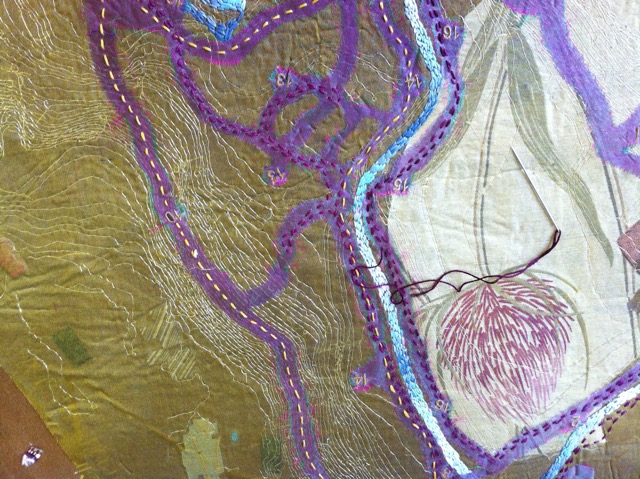
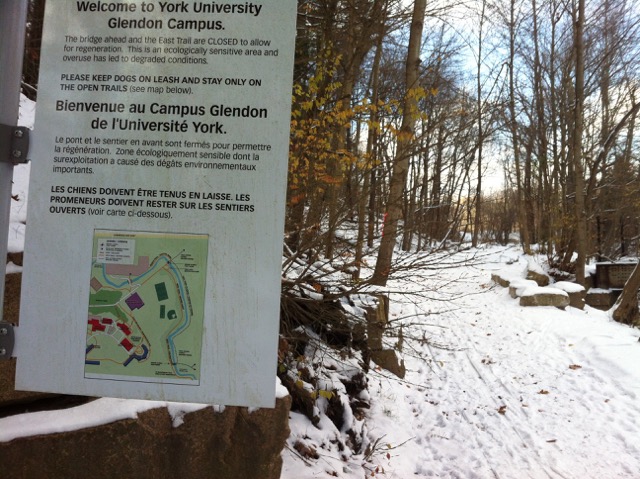
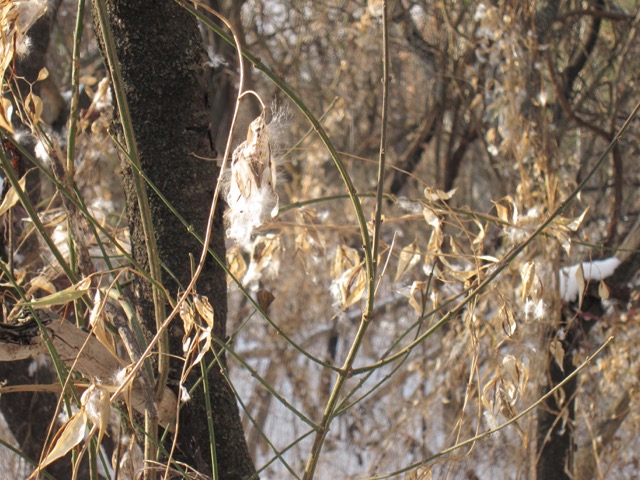
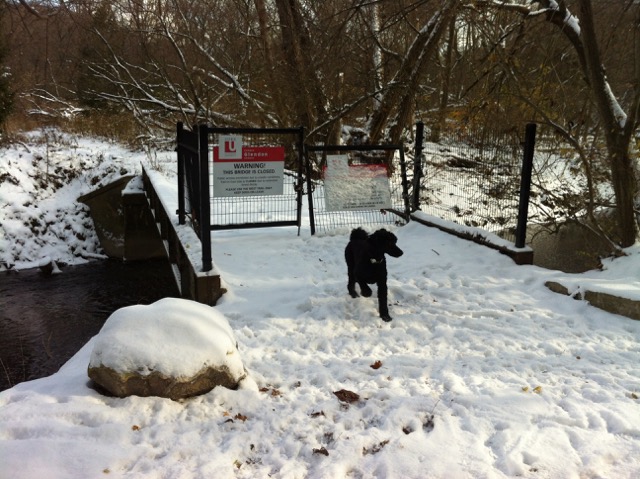
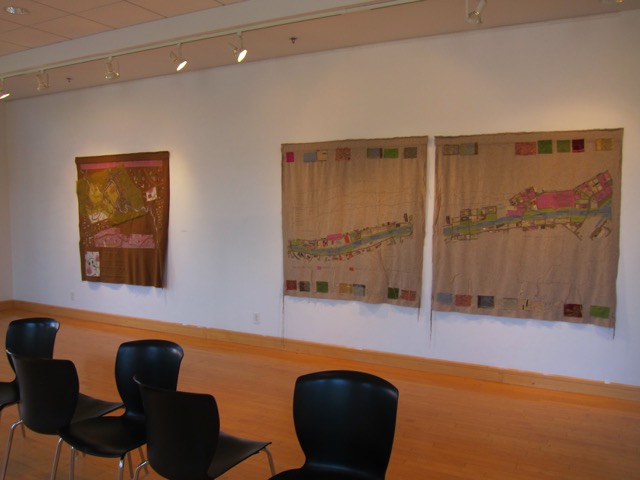
 RSS Feed
RSS Feed
